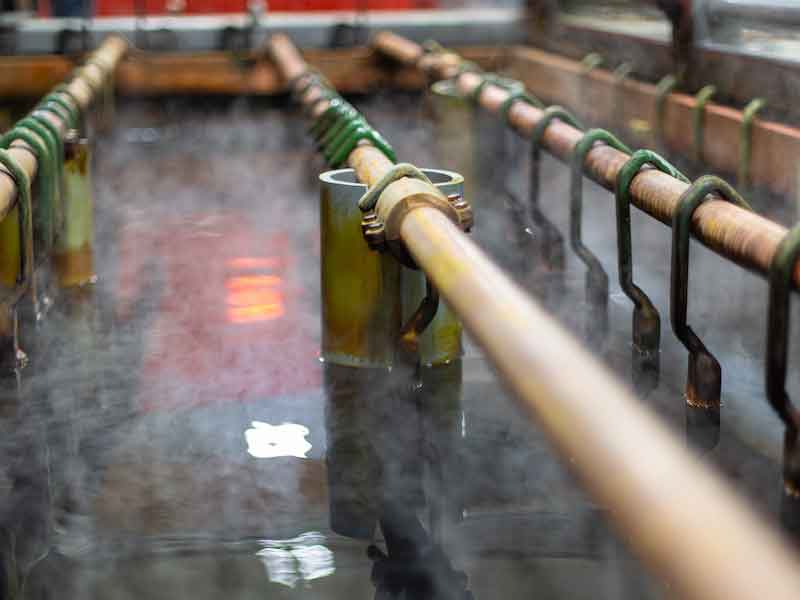While it may be true that the spotlight on the alleged health hazards of hexavalent chromium is mainly because of its use (or misuse) as a corrosion inhibitor — particularly in cooling waters and chromates — the entire chromium-based industry is bearing the burden of recent negative publicity.
 Bill CorzineChromium metal has served the industry well for many years as a decorative and/or durable finish for hardware and tools and as an excellent wear-resistant surface enhancement for, among other things, bearing and tool-and-die applications.
Bill CorzineChromium metal has served the industry well for many years as a decorative and/or durable finish for hardware and tools and as an excellent wear-resistant surface enhancement for, among other things, bearing and tool-and-die applications.
Yet, even though these products involve the use of chromium metal, which is definitely not hexavalent, governments have reacted to uninformed protest by increasing the number and complexity of rules for usage and disposal methods that affect all those who use chromium, whatever its form.
End-of-Live Vehicle Directive
The European Union, through such measures as the End-of-Life Vehicle Directive (ELV), has practically eliminated the use of chromium in the automotive industry, and Detroit automakers are rapidly following suit. Companies are rushing forward to embrace new, unproven technologies to be the first to offer alternatives to “hexavalent” chrome, whether the chrome they are replacing is hexavalent or not. Yet, with all the effort to market products as alternatives to hexavalent chrome, little effort is being expended on informing customers (or the public, for that matter) about the real nature of chromium, what hexavalent means, and how safe chromium metal really is. To those outside the metal finishing industry, our failure to defend chrome-based products suggests that we don’t fully understand our own processes. We must do more to educate people (not just ourselves) about the true characteristics of chromium and inform them about what they (and we) stand to lose should we discontinue its use.
Potential customers are rarely interested in highly technical definitions of “hexavalent.” But, whenever chromium comes up in conversation, the term “hexavalent” inevitably follows, and customers need to be assured that they are not buying anything that could haunt them later. How often do chrome platers find themselves defending their product (metallic chrome) against those who imply that, because plated chrome, which is 0-valent (electrically neutral), originates from hexavalent chromium solutions, there must be some inherent evil in the plated metal? Because questions often do arise, it is important— especially for those of us purported to be technical “experts”—to be sufficiently knowledgeable about chromium chemistry to explain why metallic chromium is not hexavalent. Not only are we placing our products under the best possible light, but we are showing that we know what it is we sell. To many potential customers, that may be our greatest asset.
Defining Hexavalent
In order to show that plated chromium metal is not hexavalent, we must be able to define “hexavalent” in a way that people can understand. The term “valence” numerically describes the tendency of an atom to combine with other atoms by its electric charge. Because the prefix hexaderives from the Greek word for six, chemists know that hexavalent chromium atoms have an electric charge of +6. (In comparison, trivalent chromium has a charge of +3.) Chemists also know that hexavalent chromium, Cr(VI), is a strong oxidizer and is, consequently, very reactive. Thus, as with most reactive chemicals, hexavalent chromium compounds must be respected.
For a reaction to occur, a second reactive specie is needed. Herein lies the issue. Hexavalent chromium would rather be in the more stable form of trivalent chromium or chromium metal. But, in order for it to make the transition, there must be a partner in the reaction that can provide the electrons necessary for the reduction (reduced electric charge) of the Cr(VI). This electron provider will then be oxidized (increased electric charge) such that the overall net charge remains 0. In other words, for hexavalent chromium to change to a non hexavalent form, something else must also be changed. The oxidizer needs a reducer and vice versa.
Since, for at least one participant in an oxidation-reduction reaction (the oxidizer), the only requirement is available electrons, we can create an “artificial” electron source in the form of a plating system. By creating an area of negative charge (excess electrons at the cathode), Cr(VI) can be reduced to metallic chromium in the plating process. The positively charged Cr(VI) atoms happily take on electrons to become neutral, independent chromium atoms. Because oxidation occurs at the anode to offset the charge imbalance, the electrical part of the plating system serves as the “reducing agent.”
The important thing to note is that the metallic chromium atoms that make up the plated chromium are no longer hexavalent. Each of the deposited atoms has gained six electrons to become an electrically neutral chromium atom. Further, these metallic chromium atoms will behave in the same way regardless of their source. It doesn’t matter if the plating was from a hexavalent bath, a trivalent bath, or any other potential source of chromium atoms. Beyond the typical formation of an oxide layer, chromium metal is not likely to react with anything except to dissolve if exposed to the proper solvent (as any metal would).
What’s All the Fuss About?
Why, then, all the ruckus about chrome? A fairly closely related process, chromating, involves the deposition of chromate salts on plated zinc as a self-healing, corrosion-resistant finish. Thus, hexavalent chromium is sold as corrosion protection, particularly for fasteners and other hardware used by the automotive industry. As an alternative to Cr(VI)-based chromate coatings, trivalent chromium is gaining use. While, chemically speaking, chromate necessarily implies hexavalent chromium (chromate = CrO42-, dichromate = Cr2O72-), the term “chromate” has come to describe the process rather than the product. Thus, we have processes based on Cr(III) compounds called “trivalent chromates,” which to chemists is an oxymoron. Undoubtedly, this subtle change in language has created some confusion.
The result of the confusion about hexavalent versus trivalent chromium in coating processes has been people tend to assume that, since traditional chromate coatings are known to contain hexavalent chromium, then products of other Cr(VI) based processes should also contain Cr(VI). Or, in order to have a Cr(VI)-free coating, a Cr(VI)-free bath must be used. So, rather than educate people about the true characteristics of metallic chromium from our traditional (and, incidentally, simple and easy to control) processes, we try to sell them “new and improved” versions. The fact is there is no difference in the end product.
Aside from the danger of cuts and scrapes as with handling any metal, electroplated chromium presents few known health risks. While the exposure of chromium metal to a highly oxidizing environment might conceivably convert metallic chromium to hexavalent chromium, such an environment would be very difficult to find in nature. It is true that much-electroplated chromium is produced from hexavalent chromium process solutions. Nevertheless, the end product is metallic chromium, which is not hexavalent. Is our silver-plated tableware dangerous because the silver metal was deposited from a cyanide solution?
Chromium can exist in several oxidation states or valences, the most common being metallic (0-charge), trivalent, and hexavalent. While hexavalent chromium has been shown to be a health hazard, metallic and trivalent chromium generally have not. The following points should be remembered when discussing potential health risks of metallic chromium:
- True chromates can and do contain hexavalent chromium. However, chromates are not metals—they are salts. Nor are they (typically) electrochemically applied. Chromate reactions are chemically spontaneous and require no external energy (electric current) to occur.
- Hexavalent chromium may be found on chromated parts but not on clean chrome-plated parts. Electroplated chromium is always 0-valent metallic chromium.
- Metallic chromium is the same regardless of its source.
- Advertising alternatives to chrome plating as containing no hexavalent chrome are purely a play on customers’ emotions. Plated chromium is not hexavalent.
Electroplated Chromium Metal Is Not Hexavalent
Any discussion about chromium must inevitably condense to this simple fact. Chromium metal is not hexavalent, nor has it been shown to be dangerous to human health. Let us do what we can to communicate the true nature of chromium to our customers and the public. We must enlighten all of our sales professionals about the characteristics and differences among chromium products. We must be able to quickly and confidently answer questions about the nature of our products, and we must be able to explain the differences between chromium metal and hexavalent chromium. And, we must stand up to those who imply that electroplated chrome is a health hazard. If we don’t answer our critics, only the fear-mongers are heard.
Bill Corzine was Director of the Corporate Laboratory for the Armoloy Corporation in DeKalb, IL, and is now retired. He holds a BS degree in chemistry from Knox College, Galesburg, IL. He was a member of the AESF Rockford Branch for many years. He was also a member of the American Chemical Society. This paper was originally published in 2004. Visit www.armoloy.com



































